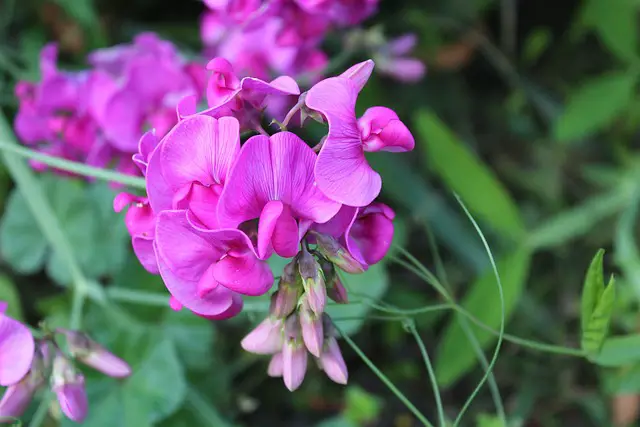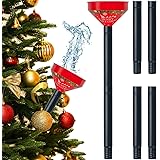Once upon a time, in a humble garden just like yours, the sweet peas were thriving. The gardener, a kind soul, had diligently sown the seeds and nurtured their growth. But alas! The sweet peas began to grow too tall, resembling beanstalks from a fairy tale more than the delicate blossoms they were meant to be.
If you’ve found yourself in a similar predicament, worry not, for today, we shall embark on a journey to understand how to stop sweet peas from growing too tall.
The Importance of Pinching
As our tale begins, the gardener discovered the power of pinching. Yes, you heard that right, pinching. It may seem counterintuitive, but pinching the tops of sweet pea seedlings is crucial for maintaining a manageable height.
When the seedlings reach about 4-6 inches tall, pinch the top 1-2 inches just above a leaf joint. This practice encourages branching and bushy growth, resulting in shorter, sturdier plants with more blooms.
Read More: About How to Make Small Lawn on Balcony?
Plant Spacing and Light Exposure
The gardener, having learned the art of pinching, continued to tend to their sweet peas. The next lesson to be learned was that of plant spacing and light exposure.
Plant your sweet peas about 6-8 inches apart to ensure they have enough room to grow without competing for resources. Adequate spacing prevents them from stretching too tall in search of light.
Speaking of light, sweet peas require a good 6-8 hours of sunlight daily. If your sweet peas are growing tall and spindly, it’s likely they are straining to reach the sunlight.
Ensure they’re planted in a location that receives plenty of light, and if necessary, consider supplementing with grow lights.
Supporting Your Sweet Peas
Now that our sweet peas have been pinched and properly spaced, it’s time to provide them with a little extra support. Sweet peas are natural climbers, and they’ll latch onto anything nearby to aid their ascent.
In our gardener’s tale, they decided to use trellises and netting to give their sweet peas a helping hand.
By providing a trellis or netting, you encourage the sweet peas to grow horizontally instead of vertically. This can help keep their height in check while also allowing for better air circulation and access to sunlight.
Regular Pruning and Deadheading
Our gardener, now well-versed in the ways of sweet pea care, moved on to the next important lesson: pruning and deadheading.
Regularly trimming and removing dead or damaged stems not only keeps your sweet peas looking their best, but it also prevents them from growing too tall.
Deadheading, or removing spent flowers, is especially important, as it stops the plant from focusing its energy on seed production. Instead, the sweet peas will concentrate on producing more blooms, resulting in a bushier, more compact plant.
Feeding Your Sweet Peas Just Right
Our gardener soon realized that the growth of their sweet peas could be influenced by the nutrients they were provided. Sweet peas, like all plants, require a balanced diet of nutrients to grow strong and healthy.
However, overfeeding them, especially with high-nitrogen fertilizers, can cause excessive growth and taller plants.
To prevent this, feed your sweet peas with a well-balanced, organic fertilizer that provides a good mix of nitrogen, phosphorus, and potassium. This will encourage healthy growth without causing them to grow too tall.
Choosing the Right Varieties
Our intrepid gardener also discovered that not all sweet peas are created equal. Some varieties naturally grow taller than others. If you wish to keep your sweet peas on the shorter side, consider selecting dwarf or bush varieties that are known for their more compact growth habits.
Some shorter sweet pea varieties include ‘Little Sweetheart’, ‘Snoopea’, and ‘Dwarf Bijou’. Planting these compact varieties will ensure that your garden remains balanced and that your sweet peas don’t tower over their neighbors.
Monitoring and Adjusting Growing Conditions
Another important lesson our gardener learned was the need to be vigilant and monitor the growing conditions of their sweet peas.
Sometimes, despite our best efforts, unexpected factors like extreme weather conditions, pests, or diseases can influence the growth of our plants.
Keep a close eye on your sweet peas and adjust their growing conditions as needed. If you notice any signs of stress, such as yellowing leaves, wilting, or stunted growth, take action to address the issue promptly.
Maintaining a healthy growing environment will help ensure your sweet peas remain compact and thriving.
A Flourishing Garden
In conclusion, our gardener’s journey has taught us the importance of a multifaceted approach to keep sweet peas from growing too tall. By employing techniques like pinching, proper spacing, ensuring adequate light exposure, providing support, feeding them just right, choosing the right varieties, and monitoring and adjusting growing conditions, you can maintain a flourishing garden with sweet peas that are just the right height.
Now, armed with these insights and wisdom, venture forth and cultivate a beautiful, well-balanced garden where your sweet peas can coexist harmoniously with their fellow plants. Enjoy the delightful fragrance and vibrant colors of your blossoms, knowing you’ve mastered the art of preventing them from becoming towering titans.
Read More: About Why Do Tomato Seedling Leaves Point Up at Night?
FAQs: Frequently Asked Questions
Your sweet pea seedlings may be growing too tall due to inadequate light exposure or lack of proper spacing. Ensure they receive enough sunlight and have ample room to grow without competing for resources.
Pinching the tops of sweet pea seedlings, providing proper spacing, ensuring adequate light exposure, and giving them support with a trellis or netting can help stop them from growing too tall.
Yes, you can cut the tops off pea plants when they reach about 4-6 inches tall. This practice, known as pinching, encourages branching and bushy growth, resulting in shorter and sturdier plants with more blooms.
To fix leggy sweet peas, start by pinching the tops to encourage bushier growth. Ensure they have proper spacing, receive adequate sunlight, and have support structures like trellises or netting. Regular pruning and deadheading will also help maintain a more compact and healthy plant.
Keeping sweet peas short involves a combination of pinching, appropriate plant spacing, sufficient light exposure, providing support with a trellis or netting, and regular pruning and deadheading.
Sweet peas can grow back after cutting, especially if you pinch or prune them correctly. Pinching the tops encourages bushier growth, while regular pruning and deadheading stimulate the production of more blooms.
The Happy Ending
In the end, our gardener discovered the secret to keeping their sweet peas from growing too tall. Through pinching, proper spacing, ensuring enough light exposure, providing support, and regular pruning and deadheading, they transformed their towering titans into a beautifully managed patch of sweet peas.
Now, equipped with this knowledge, you too can ensure that your sweet peas remain the stars of your garden, without overshadowing their companions. Happy gardening!
Auto Amazon Links: No products found.
Perfect Plants Christmas Tree Saver 8oz. | Easy Use Xmas Tree Preserver Food | Have Healthy Green Christmas Trees All Holiday Season
$9.97 (as of December 10, 2025 04:06 GMT +00:00 - More info- Product prices and availability are accurate as of the date/time indicated and are subject to change. Any price and availability information displayed on [relevant Amazon Site(s), as applicable] at the time of purchase will apply to the purchase of this product.
Rocky Mountain Goods Christmas Tree Food - 8 oz Tree Preservative - Reduce Needle Drop - Greener Scent - Fir, Pine, Spruce Trees - Extend Tree Life
$9.95 (as of December 10, 2025 04:06 GMT +00:00 - More info- Product prices and availability are accurate as of the date/time indicated and are subject to change. Any price and availability information displayed on [relevant Amazon Site(s), as applicable] at the time of purchase will apply to the purchase of this product.
VICAMB 39.3 Inch Christmas Tree Watering Funnel,Christmas Tree Watering System Device,Long Tree Watering Funnel Spout for Indoor Outdoor Xmas Tree
$17.99 (as of December 10, 2025 04:06 GMT +00:00 - More info- Product prices and availability are accurate as of the date/time indicated and are subject to change. Any price and availability information displayed on [relevant Amazon Site(s), as applicable] at the time of purchase will apply to the purchase of this product.
SUNEZLGO Christmas Tree Watering Funnel, Christmas Tree Watering System Tree Waterer, Real Christmas Tree Water Funnel, Xmas Adjustable Metal Tubes Spout for Indoor Outdoor Christmas Tree
$19.99 (as of December 10, 2025 04:06 GMT +00:00 - More info- Product prices and availability are accurate as of the date/time indicated and are subject to change. Any price and availability information displayed on [relevant Amazon Site(s), as applicable] at the time of purchase will apply to the purchase of this product.
Forest Fresh Christmas Tree Preservative Tablets – Tree Water Additive for Live Fresh-Cut Trees – Keeps Trees Hydrated and Reduces Needle Drop – Non-Toxic, Made in USA – 1 Packet (8 Tablets)
$5.99 (as of December 10, 2025 04:06 GMT +00:00 - More info- Product prices and availability are accurate as of the date/time indicated and are subject to change. Any price and availability information displayed on [relevant Amazon Site(s), as applicable] at the time of purchase will apply to the purchase of this product.
Muddy Mat® Shown on TV Super Absorbent Microfiber Dog Door Mat for Muddy Paws, Non-Slip Washable Pet Rug, Quick Dry Chenille Entryway Carpet, Machine Washable Indoor Outdoor mat, Grey 30"x19"
$24.95 (as of December 9, 2025 17:49 GMT +00:00 - More info- Product prices and availability are accurate as of the date/time indicated and are subject to change. Any price and availability information displayed on [relevant Amazon Site(s), as applicable] at the time of purchase will apply to the purchase of this product.
Snow Joe Premium Enviro Blend Ice Melt, Green-Coated Deicer Crystals, 50 lb - Safer Melter for Vegetation, Concrete & Metals w/ Anti-Corrosion Calcium Magnesium Acetate
$32.97 (as of December 9, 2025 17:49 GMT +00:00 - More info- Product prices and availability are accurate as of the date/time indicated and are subject to change. Any price and availability information displayed on [relevant Amazon Site(s), as applicable] at the time of purchase will apply to the purchase of this product.
Zevo Flying Insect Trap Official Refill Cartridges - Fits Both Zevo Trap & MAX Indoor Fly Trap - Authentic Trap+Lock Technology to Catch Gnats, House & Fruit Flys (4 Official Refill Cartridges)
$11.01 (as of December 9, 2025 17:49 GMT +00:00 - More info- Product prices and availability are accurate as of the date/time indicated and are subject to change. Any price and availability information displayed on [relevant Amazon Site(s), as applicable] at the time of purchase will apply to the purchase of this product.
OLANLY Dog Door Mat for Muddy Paws 30x20, Absorbs Moisture and Dirt, Absorbent Non-Slip Washable Doormat, Quick Dry Chenille Mud Mat for Dogs, Entry Indoor Entryway Carpet for Inside Floor, Grey
$9.99 (as of December 9, 2025 17:49 GMT +00:00 - More info- Product prices and availability are accurate as of the date/time indicated and are subject to change. Any price and availability information displayed on [relevant Amazon Site(s), as applicable] at the time of purchase will apply to the purchase of this product.
ivtivfu Rolling Grill Basket, Removable Wooden Handle, 304 Stainless Steel, Nesting BBQ Tools, Smoker Grilling Accessories for Vegetable, Outdoor Cooking Camping, Birthday Gifts for Men Dad Husband
$24.99 (as of December 9, 2025 17:49 GMT +00:00 - More info- Product prices and availability are accurate as of the date/time indicated and are subject to change. Any price and availability information displayed on [relevant Amazon Site(s), as applicable] at the time of purchase will apply to the purchase of this product.













